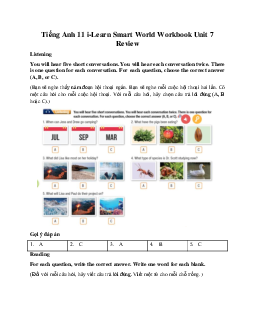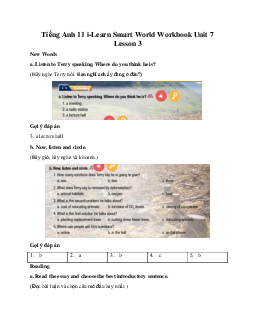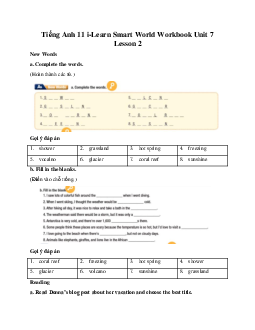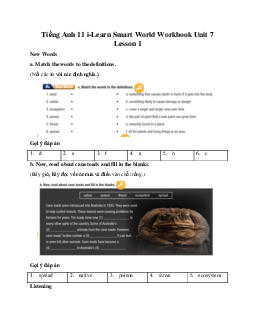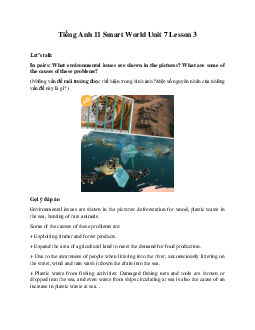








Preview text:
Tiếng Anh 11 Smart World Unit 7 Lesson 1 Let's Talk!
In pairs: What problem can you see in the picture? What other damage to the
environment do you think natural creatures can cause?
(Theo cặp: Bạn có thể nhìn thấy vấn đề gì trong hình? Bạn nghĩ các sinh vật tự nhiên có
thể gây ra thiệt hại nào khác cho môi trường?) Gợi ý đáp án
The painting shows the locusts destroying the farmers' crops.
Natural creatures can become the killer of many rare plant and animal species,
threatening biodiversity and disrupting ecological balance. New Words
a. Circle the correct definitions for the underlined words. Listen and repeat.
(Khoanh tròn các định nghĩa đúng cho các từ được gạch chân. Lắng nghe và lặp lại.) Gợi ý đáp án 1. a 2. a 3. b 4. a 5. a 6. b
b. In pairs: Say what you know about these plants and animals.
(Theo cặp: Nói những gì bạn biết về các loài thực vật và động vật này.) Gợi ý đáp án
Monkeys and humans share a common ancestor and belong to the order primates.
Turtle is a symbol of longevity, long life, forever.
Crocodiles exist in most areas of the world, living in rivers and wetlands.
Bamboo has been an extremely intimate and close attachment for the Vietnamese people for many generations.
Coconuts are ubiquitous in coastal tropical regions and are a tropical cultural icon. Listening
a. Listen to two students talking about foreign species. How does Steven feel about them?
(Nghe hai sinh viên nói về các loài ngoại lai. Steven cảm thấy thế nào về chúng?) Gợi ý đáp án 1. interested
b. Now, listen and circle True or False.
(Bây giờ, hãy lắng nghe và khoanh tròn Đúng hoặc Sai.) Gợi ý đáp án 1. False 2. False 3. True 4. False 5. True
c. Read the Conversation Skill box. Then, listen and repeat.
(Đọc hộp Kỹ năng đàm thoại. Sau đó, nghe và lặp lại.)
d. Now, listen to the conversation again and circle the phase you hear.
(Bây giờ, hãy nghe lại đoạn hội thoại và khoanh tròn câu mà bạn nghe được.)
e. In pairs: Should people be allowed to have foreign species for pets? Why (not)?
(Theo cặp: Mọi người có nên được phép nuôi các loài ngoại lai làm vật nuôi không? Tại sao không)?) Gợi ý đáp án
I think people should not be allowed to keep exotic species as pets because they can pose
health risks to humans. Many exotic animals are carriers of zoonotic diseases, such as
Herpes B, Monkeypox, and Salmonellosis, all of which can be transmitted to humans.
Grammar Meaning and Use
a. Look at the picture. What do you think the women are saying?
(Nhìn vào bức tranh. Bạn nghĩ những người phụ nữ đang nói gì?) Gợi ý đáp án
How long have you been studying wild pigs?
I’ve been studying them for six years.
b. Now, listen and check your ideas.
(Bây giờ, hãy lắng nghe và kiểm tra ý tưởng của bạn.) c. Listen and repeat.
(Lắng nghe và lặp lại.)
Grammar Form and Practice
a. Fill in the blanks with Present Perfect Continuous form of the verbs in brackets.
(Điền vào chỗ trống dạng Hiện tại hoàn thành tiếp diễn của động từ trong ngoặc.) Gợi ý đáp án 1. has been trying 2. have been competing 3. haven’t been working 4. have - been affecting 5. Has - been decreasing 6. have been spreading
b. Circle the correct verb form.
(Khoanh tròn dạng đúng của động từ.) Gợi ý đáp án 1. have been eating 2. tried 3. wanted 4. have been working 5. tested
c. In pairs: Why do you think some foreign animals have been spreading to other
places? How have foreign animals been affecting the environment in your country?
(Theo cặp: Tại sao bạn nghĩ rằng một số động vật ngoại lai đã lan rộng đến những nơi
khác? Động vật ngoại lai đã ảnh hưởng đến môi trường ở nước bạn như thế nào?) Gợi ý đáp án
Because higher average temperatures and changes in rain and snow patterns caused by
climate change will enable some invasive plant species—such as garlic mustard, kudzu,
and purple loosestrife—to move into new areas.
Foreign animals have caused the environment in my country to be unbalanced, causing
some dangerous respiratory diseases for humans. Pronunciation
a. Focus on the /sp/ sound (Tập trung vào âm /sp/)
b. Listen to the words and focus on the underlined letters.
(Nghe các từ và tập trung vào các chữ cái được gạch chân.)
c. Listen and circle the words you hear.
(Nghe và khoanh tròn những từ bạn nghe được.) Gợi ý đáp án 1. spread (loài) 2. pieces (mảnh) 3. speak (nói)
d. Take turns saying the words in Task c while your partner points to them.
(Thay phiên nhau nói các từ trong Nhiệm vụ c trong khi đối tác của bạn chỉ vào chúng.) Practice
a. Practice the conversation. Swap roles and repeat.
(Thực hành các cuộc đối thoại. Trao đổi vai trò và lặp lại.)
b. Make two more conversations using the ideas on the right.
(Thực hiện thêm hai cuộc hội thoại bằng cách sử dụng các ý tưởng bên phải.) Gợi ý đáp án
Richard: Hello, thanks for agreeing to do this interview. Margaret: No problem.
Richard: Could you tell me about what you do?
Margaret: Sure. I'm a biologist. I study foreign species, and I've been studying their
impact on our environment for ten years.
Richard: Which species are you studying at the moment?
Margaret: The fire ant. It's native to South America but has spread to many states in the USA.
Richard: How long has your team been studying it?
Margaret: For about three years.
Richard: And what damage has it caused?
Margaret: The ants have destroyed lots of farms. Richard: What do you mean?
Margaret: They make holes in the ground, so it’s difficult for plants to grow.
Richard: I see. So what are you doing to stop them?
Margaret: We have tried many things, but since last year we've been releasing special
flies that put eggs in the ants' heads. The eggs grow and kill the ants.
Richard: Has it been successful? Margaret: Yes, it has.
Richard: Great! Thank you, that was very interesting. Speaking
Speaking INTERVIEW: THREAT FROM FOREIGN SPECIES (PHỎNG VẤN: ĐE
DỌA TỪ CÁC LOÀI NGOẠI LAI)
Ask for clarification (Hỏi để làm rõ)
a. You're a reporter interviewing a scientist, who's studying a foreign species. In
pairs: Student B, Student A, you're the reporter. Interview the scientist and complete the table.
(Bạn là một phóng viên phỏng vấn một nhà khoa học đang nghiên cứu một loài ngoại lai.
Theo cặp: Học sinh B, Học sinh A, bạn là phóng viên. Phỏng vấn nhà khoa học và hoàn thành bảng.)
b. Swap roles and repeat.
(Trao đổi vai trò và lặp lại.)
c. Which species is a bigger threat to ecosystems? Why?
(Loài nào là mối đe dọa lớn hơn đối với hệ sinh thái? Tại sao?) Gợi ý đáp án
The main threat to ecosystems is the large and diversified number of exotic organisms
(plant, animals, bacterial, and viral diseases), many of which have become invasive. Most
of the introduced organisms are competitors, predators, parasites for native species, or
reservoirs of diseases that later spread to organisms. The ecological impact of exotic
organisms is worsened, because native species have not usually evolved immunological
defenses against recently introduced diseases or developed behaviors and other life-
history strategies to counteract the effects of exotic predators and competitors.
